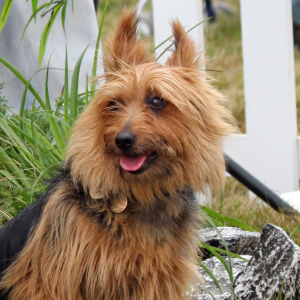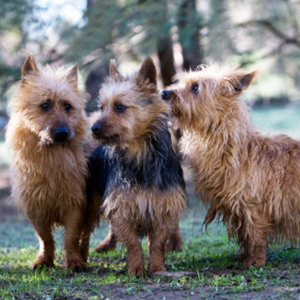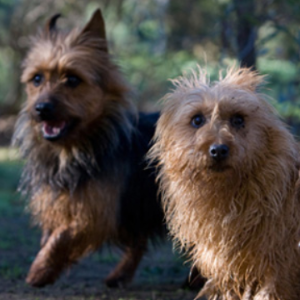
Australian Terrier
The Australian Terrier makes a delightful family pet. Highly loyal, they’re dedicated to—and demand a lot of attention from—their people.
Interested in discovering if your dog is an Australian Terrier?
Check out Wisdom Panel's DNA tests.

Australian Terrier Traits
General Appearance
The Australian Terrier may be small in stature, but they offer boundless energy and companionship.
The breed has distinct coat furnishings around their forequarters and neck, and the plume of soft and silky hair on the top of their head is different in texture from the rest of their coat. Their dark eyes give you a glimpse into their playful personality.
Coat and Colouring
The Australian Terrier has a harsh and straight weatherproof outer coat with a short and soft undercoat. Australian Terrier’s coats are usually blue and tan, solid sandy, or solid red.
Their “topknot,” or the soft and silky plume of hair at the top of their head, is made of finer and softer hair than the rest of their coat.
Distinctive Physical Traits
The Australian Shepherd is a small and sturdy bread with pricked ears and a short tail. The “topknot” found at the top of their head is soft and silky, in contrast to the rest of their harsh coat.
Australian Terrier Temperament
The Australian Terrier is loyal and loving, a friend to both young kids and older people. They can be bossy and demanding, so proper socialization is important. In general, though, Australian Terriers are lively and energetic, ready to play with their people, and then cuddle on the couch when playtime is over.


Australian Terrier History
The Australian Terrier likely hails from the breeding of many terrier breeds, namely the Yorkshire, Scottie, Norwich, Skye, Cairn, and Dandie Dinmont terriers. The breed came about to act as fearless exterminators of snakes and other small mammals.
When British settlers arrived in Australia in the 19th century, they brought their dogs with them. Lonely and removed, these settlers and their dogs came to rely on each other for company. As it turned out, this particular breed was just as ready to cuddle as they were to spend long, hard days at work.
Despite its British roots, the Terrier is Australian through and through. It was the first native breed to receive official recognition there—it was also the first Australian breed to be recognized outside of the country too. The American Kennel Club registered the breed in 1960.
Australian Terrier Care
Nutrition
The Australian Terrier is an active breed that does best with high-quality dog food that’s suited to their particular age, as well as any additional health concerns.
As with any dog, it’s important to monitor the amount of food and treats that you give your Australian Terrier, especially since some dogs may be prone to gaining weight as they age. Your veterinarian is always a good source to help provide you with appropriate nutrition and feeding guidelines.
Grooming
This breed has a harsh and weatherproof outer coat that repels dirt well, so it’s relatively easy to maintain. A once a week brushing with a brush or grooming mitt should help keep it in shape. This particular breed can also have long hairs that grow adjacent to the eyes, which can irritate the eyes if left unmanaged. Usually, the hairs can be easily plucked while grooming.
All dogs require regular dental care, including at-home teeth brushing and professional dental cleanings, and the Australian Terrier is no exception. Maintaining good dental hygiene is important for their overall long-term health.
Exercise
Like most terriers, the Australian Terrier is a high-energy, active breed that requires a lot of regular exercise. When left without ways to burn off their energy, they may turn to undesirable habits, like digging.
Luckily, these dogs love spending time with their people, so activities like walks or playing fetch (in a fenced area) work well. Because the Australian Terrier has a strong urge to hunt, they should always be leashed or in a secure area when outside.
Training
Although Australian Terriers can be stubborn, they love their people, so training is just another way for you to spend time together. They do tend to get bored easily, so it’s best to keep the sessions short.
Without proper training and socialization, Australian Terriers can develop some undesirable habits, like digging. They can also be bossy and territorial, and it may be difficult for them to share a home with other animals.

Australian Terrier Genetic Health Conditions
-
Craniomandibular Osteopathy (Discovered in the Australian Terrier)
Craniomandibular Osteopathy (CMO), also known as "lion's jaw," is a disorder of bone growth, with bones of the skull most consistently affected. During the growth period, the jaw bones become swollen and thickened, causing pain, drooling, and difficulty eating. The associated genetic variant has been identified in the Australian Terrier.
Knowing if your Australian Terrier is a carrier or at-risk for these conditions can help you and your veterinarian plan for your pup's lifelong care. With Wisdom Panel™ Premium, you can get results for over 200 genetic health tests.
Breed Group
Terrier
The Terrier Group ancestors were bred to hunt and kill vermin. They are often characterized as feisty and energetic dogs whose sizes range from fairly small to much larger.































































